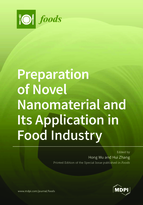Preparation of Novel Nanomaterial and Its Application in Food Industry
A special issue of Foods (ISSN 2304-8158). This special issue belongs to the section "Food Engineering and Technology".
Deadline for manuscript submissions: closed (15 October 2021) | Viewed by 42921
Special Issue Editors
Interests: nanomaterial; encapsulation; electrospinning and electrospraying; food packaging; oral intestinal-targeted delivery system; bioactives extraction and application; functional food
Interests: food oil; food protein; packaging material for food; functional health product development
Special Issues, Collections and Topics in MDPI journals
Special Issue Information
Dear Colleagues,
Nanotechnology has offered a wide range of opportunities for the development and application of structures, materials, or systems with new properties in the food industry in recent years. The developed nanomaterials could greatly improve not only food quality and safety but also the foods’ health benefits. Therefore, the great potential of nanomaterial has provided a new perspective for researchers to dive deep into the material at the nano level. It is essential to further come up with novel techniques, methods, and products that have a direct application to nanotechnology in food science. This Special Issue aims to provide an overview of the current and projected outcomes made on nanoscience and nanotechnology fields, from nanomaterials design, conception and characterization to its application in a variety of food-related industries. Researchers are invited to submit their up-to-date original research articles, review works, and short communications to this Foods Special Issue: “Preparation of Novel Nanomaterial and its Application in Food Industry”.
Prof. Dr. Hong Wu
Prof. Dr. Hui Zhang
Guest Editors
Manuscript Submission Information
Manuscripts should be submitted online at www.mdpi.com by registering and logging in to this website. Once you are registered, click here to go to the submission form. Manuscripts can be submitted until the deadline. All submissions that pass pre-check are peer-reviewed. Accepted papers will be published continuously in the journal (as soon as accepted) and will be listed together on the special issue website. Research articles, review articles as well as short communications are invited. For planned papers, a title and short abstract (about 100 words) can be sent to the Editorial Office for announcement on this website.
Submitted manuscripts should not have been published previously, nor be under consideration for publication elsewhere (except conference proceedings papers). All manuscripts are thoroughly refereed through a single-blind peer-review process. A guide for authors and other relevant information for submission of manuscripts is available on the Instructions for Authors page. Foods is an international peer-reviewed open access semimonthly journal published by MDPI.
Please visit the Instructions for Authors page before submitting a manuscript. The Article Processing Charge (APC) for publication in this open access journal is 2900 CHF (Swiss Francs). Submitted papers should be well formatted and use good English. Authors may use MDPI's English editing service prior to publication or during author revisions.
Keywords
- nanomaterials
- food processing
- food packaging
- food safety
- nano-sensors
- functional food
- nanostructured food ingredient
- encapsulation/absorption
- nanotechnology applications








